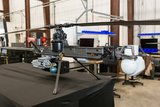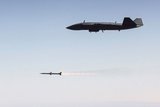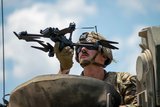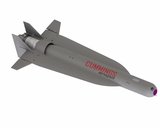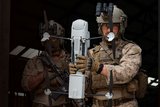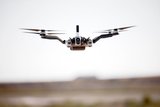2nd Boeing-built Orbital Test Vehicle X-37B begins flight
Boeing today announced the successful launch of the second Boeing-built X-37B Orbital Test Vehicle (OTV) for the US Air Force Rapid Capabilities Office (RCO). The OTV was launched on an Atlas V rocket into a low-Earth orbit today at 5:46 p.m. Eastern time from Cape Canaveral Launch Complex 41.
"History was made in December when the X-37B became the United States' first unmanned vehicle to return from space and land on its own," said Craig Cooning, vice president and general manager of Boeing Space & Intelligence Systems. "The success of that mission validated this reusable and effective way to test new technologies in space and return them for examination.
"Today, we took another important step with the successful launch of the second OTV, enabling the RCO to further experiment with the vehicle and its ability to operate in low-Earth orbit," Cooning continued. "Close teamwork between the Air Force Rapid Capabilities Office, the United Launch Alliance Atlas team, and the 45th Space Wing at Cape Canaveral Air Force Station made this launch a success."
The first OTV was launched in April 2010 and orbited for approximately eight months. In December, it successfully de-orbited and landed at Vandenberg Air Force Base, Calif., where it continues to undergo post-flight evaluation.
The X-37B design combines the best of aircraft and spacecraft design into an affordable, unmanned space-based test platform. Program objectives include space experimentation, risk reduction, and concept-of-operations development for reusable space vehicle technologies.
Boeing's commitment to this space-based unmanned vehicle spans a decade and includes support to the Air Force Research Lab's X-40 program, NASA's X-37 program, and the Defense Advanced Research Projects Agency's X-37 Approach, Landing and Test Vehicle program.
Boeing program management, engineering, test and mission support functions for the OTV program are conducted at Boeing sites in Huntington Beach, Seal Beach, and El Segundo, Calif.
Source: Boeing
More from Uncrewed Vehicles
-
![What's next for the Pentagon after the Replicator programme?]()
What's next for the Pentagon after the Replicator programme?
Although the Replicator initiative has made several accomplishments, there are still multiple gaps to plug across the US Department of Defense (DoD) and its services.
-
![Cummings Aerospace showcases Hellhound loitering munition designed for US Army’s LASSO programme (video)]()
Cummings Aerospace showcases Hellhound loitering munition designed for US Army’s LASSO programme (video)
Cummings Aerospace presented its turbojet-powered Hellhound loitering munition at SOF Week 2025, offering a man-portable solution aligned with the US Army’s LASSO requirements.
-
![SOF Week 2025: PDW unveils attritable FPV drone for SOF operations at scale]()
SOF Week 2025: PDW unveils attritable FPV drone for SOF operations at scale
PDW has revealed its Attritable Multirotor First Person View drone at SOF Week 2025, offering special operations forces a low-cost, rapidly deployable platform for strike and ISR missions, inspired by battlefield lessons from Ukraine.
-
![SOF Week 2025: Teledyne FLIR white paper provides guidance on reusable loitering munitions]()
SOF Week 2025: Teledyne FLIR white paper provides guidance on reusable loitering munitions
Teledyne FLIR is highlighting the emerging requirements for 'recoverable and re-usable' loitering munitions across the contemporary operating environment during this week’s SOF Week conference in Tampa, Florida.
-
![SOF Week 2025: Kraken Technology group debuts K3 Scout USV in North America]()
SOF Week 2025: Kraken Technology group debuts K3 Scout USV in North America
High-performance maritime industry player Kraken Technology Group, based in the UK, has used the SOF Week conference in Tampa, Florida this week to debut its K3 Scout uncrewed surface vessel (USV) to the North American market.
-
![Palladyne AI and Red Cat to demonstrate capabilities for autonomous drone swarms to the US military]()
Palladyne AI and Red Cat to demonstrate capabilities for autonomous drone swarms to the US military
Red Cat and Palladyne AI recently conducted a cross-platform collaborative flight involving three diverse heterogeneous drones.









